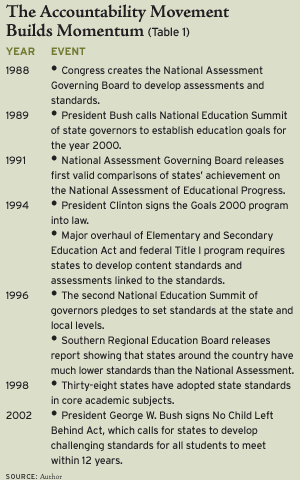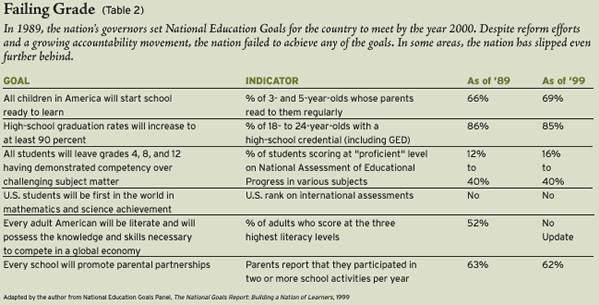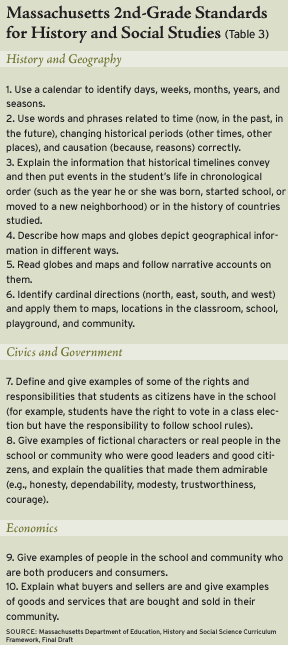 |
| Illustration by Stuart Bradford.
|
A Nation at Risk foreshadowed the modern accountability movement. While the word “accountability” never appears in Risk, its call for higher academic standards and its focus on student achievement as the main barometer of quality laid the intellectual groundwork for the rigorous curricula and tests envisioned by the promoters of standards-based and “systemic” reform in the late 1980s and early 1990s. What Risk lacked was a mechanism to ensure that its recommendations would be implemented. Its authors trusted the nation and its schools to rally around the cause of education reform. The rewards and sanctions, the carrots and sticks, of the modern accountability movement were absent from Risk.
A significant milestone in the accountability movement was the National Governors’ Association’s 1989 “Education Summit” in Charlottesville, Virginia, at which then-president George Bush, the nation’s governors, and business leaders gave impetus to business-style accountability for schools (see Table 1 for a timeline of accountability). Systemic reform, as recommended by summiteers, meant aligning the chief components of education: academic goals, curricula, instruction, and exams.
 |
School accountability was thought to require simultaneous centralization and decentralization: the centralization of standards at the state level and the decentralization of operational responsibilities to the district or school level. State policymakers were to set goals and measure progress, but to free local school districts and schools to develop and execute effective practices.
The development of state curriculum standards and tests aligned to the standards continued throughout the 1990s. However, the sanctions for poor performance have barely even been tested. In nearly all states, schools and educators continue to function and remain employed even when gross incompetence and malpractice have been evident for years. As a result, not even one of the National Educational Goals set at the 1989 Charlottesville summit has been accomplished (see Table 2). Some results, such as high-school graduation rates, were even worse after a decade or so of effort. Only one state, Connecticut, could claim that more than a third of its students met the standards for “proficiency” in 8th-grade mathematics set by the National Assessment Governing Board, which Congress created to set forth national standards and to measure their degree of attainment.
The underlying standards are also weak in most states. In studying state accountability systems in 1999, the Thomas B. Fordham Foundation labeled 21 states “irresponsible,” possessing both weak accountability and either weak or no standards. Only eight states-Alabama, Arizona, California, Massachusetts, North Carolina, South Dakota, South Carolina, and Texas-merited a grade of A or B for their solid standards.
 |
What do good standards look like? The Massachusetts History and Social Science Curriculum Framework is notable. The framework begins with three convictions: that democracy is the worthiest form of government, that its spread cannot be taken for granted, and that its survival depends on each new generation’s acquiring loyalty to the vision of the American founders.
In seven “Guiding Principles,” the framework sets forth requirements for all K-12 history and social science content: courses must 1) emphasize the development of the political principles and institutions of Western civilization; 2) recognize each person as an individual while developing a common American civic identity; 3) develop an understanding of the world outside the United States; 4) teach social science through current events and public policy; 5) continuously impart history and social science from pre-K through high school; 6) integrate content, concepts, and skills in a coherent course of study; and 7) draw on non-social science disciplines such as the fine arts, literature, and mathematics. These principles are exemplified in the ten concepts and skills for 2nd grade that are enumerated in Table 3.
 |
Those states that have instituted reasonably tough standards and accountability systems have experienced real gains in achievement. In particular, the National Assessment of Educational Progress (NAEP) scores of Texas and North Carolina advanced more than in any other state under accountability systems that included:
• grade-by-grade standards with aligned curricula and textbooks;
• statewide assessments linked to the standards;
• accountability for results, with rewards and sanctions for performance;
• deregulation and increased flexibility in ways the standards can be met; and
• computerized feedback systems and publicly available data on achievement.
Though some educators have protested the expense of accountability systems, Harvard economist Caroline Hoxby has found that they represent a minuscule percentage of school budgets. The payments to commercial firms for standardized testing, standard setting, and accountability in year 2000 amounted to $234 million, less than 0.1 percent of K-2 spending. On average, this represented $5.81 per American student and ranged between $1.79 and $34 for the 25 states with information available. Moreover, these costs will undoubtedly decline in the longer run. They were estimated as states were developing their accountability systems. Once the systems are established, much of the activity can be routinized at lower costs.
The No Child Left Behind Act (NCLB) represents, at least in principle, the biggest step ever in bringing accountability to the schools. The question is whether its mandates will be well implemented, if they’re implemented at all. After all, as of 2001, only 19 states had complied with requirements of the 1994 reauthorization of the Elementary and Secondary Education Act. Many states would have to expend considerable effort to be in nominal compliance with the new law. Indeed, as of September 2002, at least five states had the mistaken impression that they need not meet a key requirement of NCLB for the present school year: to provide tutoring and other supplemental services for students in failing schools.
It remains to be seen whether the federal government will withhold funds from congressional districts that fail to comply with the law. Even if the mandates are well implemented, there are reasons to doubt the ability of NCLB to raise achievement. At the end of the day, no matter what 50 state departments of education discover in the many complex pages of federal legislation and then promulgate as official policy to local districts and schools, teachers may continue as they please. Despite the policy crescendo of state standards, tests, and accountability, a gulf remains between what teachers teach and what is called for in the kind of standards-based reform represented by NCLB. For accountability to work, it must invade the prime sanctuary in today’s schools: the classroom.
-Herbert J. Walberg is emeritus professor of education and psychology at the University of Illinois at Chicago and a visiting fellow at the Hoover Institution, Stanford University.


